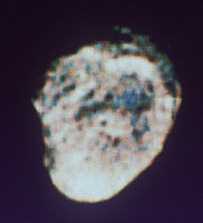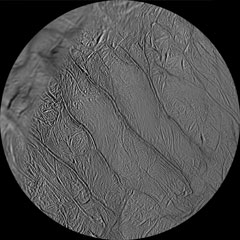Medium-sized moons of Saturn shown alongside Earth's Moon.
Click on image for full size
Original Windows to the Universe artwork by Randy Russell using images courtesy NASA.
Medium-sized Moons of Saturn
Saturn has
moons. Many of those are tiny chunks of rock or ice only a few kilometers (miles) across. One of Saturn's moons, Titan, is much larger than the rest and is amongst the largest moons in our entire Solar System.
Midway in size between Titan and the many tiny moonlets are several medium-sized moons. The image on this page shows the mid-sized moons of Saturn. They
are, in order from largest to smallest: Rhea, Iapetus, Dione, Tethys, Enceladus,
Mimas, Hyperion, Phoebe, Janus, Prometheus, Epimetheus and Pandora. The picture also shows Earth's Moon for size comparison.
You might also be interested in:

Titan is a moon of the planet Saturn. It is Saturn's largest moon. Titan is the second largest moon in the whole Solar System. It is larger than Earth's moon. It is even larger than two planets - Mercury
...more
This is a picture of the Earth's moon, in the center, compared to several other moons. The picture shows that the Earth's moon is a lot smaller than Ganymede, Callisto, and Titan. The Earth's moon is about
...more
Rhea was discovered by G. Cassini in 1672. Rhea is the 5th farthest moon from Saturn. Rhea is one of the icy moons. Rhea is about as wide as the state of California is long. Rhea is has many craters and
...more
Dione was discovered by G. Cassini in 1684. Dione is the 7th farthest moon from Saturn. It is a small icy moon, lightly cratered, with white streaks across the surface. Dione is about as wide as the Oregon
...more
Tethys was discovered by G. Cassini in 1684. Tethys is the 8th closest moon to Saturn. Tethys is one of the icy moons. It is about as wide as the length of the Oregon coast. Tethys is has a surface, with
...more
Saturn has // Call the moon count function defined in the document head print_moon_count('saturn'); moons. Enceladus is one of them. Enceladus is the sixth biggest moon of Saturn. The diameter of Enceladus
...more
Hyperion was discovered by W. Bond in 1848. Hyperion is the 3rd farthest moon from Saturn. Hyperion is about the size of a large county or small state. One of the main things about Hyperion is its unusual
...more
Enceladus is an icy moon of Saturn. The South Pole of Enceladus is one of the strangest places in the Solar System. There are several huge cracks in the surface of Enceladus near its South Pole. The cracks
...more















